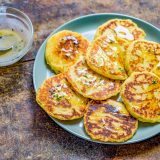Sunrise drifted over the helter-skelter landscape of Fez, Morocco, as we sat down to breakfast on the rooftop of our riad. Unlike Marrakech, Fez is a softly rolling cityscape. It’s not anchored to a flat plain, but undulating, with thousands of small whitewashed buildings swelling into a wave, cresting over the next hill, then rolling on.
I expected to breakfast on tiny glasses of tropical orange juice perfumed with hints of jasmine and honeysuckle, sweet and fragrant. And then a small glass pot of yogurt that tasted alive, as if it had just come from the goat or cow—not the insipid muck sold in American supermarkets.
But I was surprised when a tagine pot was placed in front of me, the cone-like top lifted to reveal a ¾-inch-thick round of bread reminiscent of a particularly delicate variety of cornbread married to an English muffin. It was delicious slathered with honey or jam and washed down with hot mint tea.
Much as I wanted to, I never learned how to make that bread, nor did I learn its name. As time went on, eventually I forgot about it. That is, until recently, when J.M. Hirsch, Milk Street’s editorial director, described harcha, a Moroccan bread made with semolina and baking powder, cooked quickly on a griddle or, in my case, baked in a tagine. It was the main course in my lost breakfast! Now I needed to know how to make it at home.
We started by checking Paula Wolfert’s recipe in “The Food of Morocco,” which begins by rubbing hunks of softened butter and olive oil into semolina flour. It also includes milk (or buttermilk), honey and a coating of semolina before cooking.
Questions arose about the resting time needed to allow the semolina to absorb moisture, the best way to shape and roll out the dough and the best size for the rounds. The harcha I had enjoyed in Fez was large, close to the diameter of the tagine, but other versions were just a few inches across.
For proper hydration, we found that mixing the semolina with hot water and letting it rest for 10 minutes provided the best texture. Adding the butter before the yogurt (which we used instead of milk) was essential; the fat coated the flour to prevent gluten formation. Cutting chilled butter into the flour with a fork was an old-fashioned method but still the best; we found that melted butter produced a somewhat heavier, greasier texture.
We divided the dough into eight balls, pressed each into the size of an English muffin, then briefly refrigerated them to firm them. Medium heat, not low, cut the cooking time down to two minutes per side in a nonstick skillet; a well-seasoned cast-iron skillet would also work. And we left off any semolina coating so as to give the bread a smoother, more refined finish.
Think of harcha as a Moroccan pancake or a modified English muffin. It’s as easy to make as a biscuit but tastes like a world where sunrise has gently washed across the rooftops for a thousand years.




